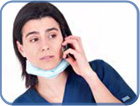Should Dental Offices Be No-Phone Zones?
Should Dental Offices Be No Phone Zones? Patients or practitioners who use cell phones during oral hygiene care appointments or other dental procedures may be endangering the health of clinicians, office staff, and other patients. The danger may be lurking
Should Dental Offices Be No-Phone Zones?
 Patients or practitioners who use cell phones during oral hygiene care appointments or other dental procedures may be endangering the health of clinicians, office staff, and other patients. The danger may be lurking on their cell phones and other mobile devices, according to a new Turkish study published in the American Journal of Infection Control.
Patients or practitioners who use cell phones during oral hygiene care appointments or other dental procedures may be endangering the health of clinicians, office staff, and other patients. The danger may be lurking on their cell phones and other mobile devices, according to a new Turkish study published in the American Journal of Infection Control.
A team from the Department of Medical Microbiology at Inonu University in Malatya, Turkey, collected swab samples from 200 cell phones, including 133 phones belonging to patients and visitors, and 67 phones belonging to health care workers. Cultures from samples taken from keypads, microphones, and earpieces revealed that 39.6% of the patient group phones tested positive for bacteria vs 20.6% of the health care workers’ phones. Researchers concluded that patients’ cell phones were twice as likely to contain bacterial pathogens as those of health care professionals.
In addition, the nature of some of the contaminants found—including multidrug resistant pathogens such as Staphylococcus aureus and multi-resistant gram-negative organisms—was troubling, leading the researchers to state: “The types of bacteria that were found on the patients’ cell phones and their resistance patterns were very worrisome. Specific infection control measures may be required for this threat.”
As cell phone use increases among the patient population, so does risk of cell phone contamination and the potential for these pathogens to colonize in oral health care settings. The obvious conclusion for practitioners is to adhere to an up-to-date infection control protocol to protect yourself, your office and your patients from exposure to cell phone-derived pathogens.
Source: Association for Professionals in Infection Control and Epidemiology

